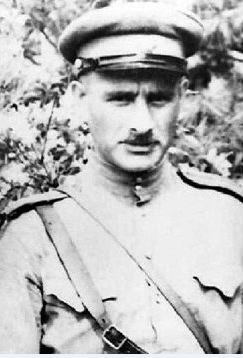Aron Stomakhin was born in 1919 in the town of Tarashcha, 100 kilometers south of Kiev, Ukraine. In 1940, he graduated from the Kiev Polytechnic Institute and worked at a Kiev factory as an engineer. In the same year, he was drafted into the Red Army, to the airborne forces. With the beginning of the Soviet-German war, his airborne division was deployed in the Baltic countries (which had recently been annexed to the Soviet Union), and later took part in the defense of Moscow. Here, Stomakhin was wounded. After being discharged from hospital, he was sent to a brief course for commanders. Upon completing it, he became the instructor of a reconnaissance and sabotage group, which was to be airdropped behind enemy lines. He quickly rose to the position of head of the airborne and parachute service of the "special school" for diversionists. When the 16th Guards Airborne Division was formed in January 1944, Stomakhin, despite his rank of lieutenant, became the commander of the airborne- and parachute service of the Division. Stomakhin himself carried out several sabotage assignments in the enemy rear, and was awarded the Order of the Red Banner.
Being a gifted engineer, Aron Stomakhin also came up with several inventions in the course of the war, including a lighting device that could be lifted to the desired altitude by an aerostat (gas balloon). This device came to be known as "SAS" (Signal Apparatus of Stomakhin) in the army, with a modernized model named "SAS-2" being issued later.
However, Guards Captain Stomakhin achieved his greatest fame for the "stunt" that he pulled off in Vienna on April 13, 1945. That day, Stomakhin, assisted by several privates, managed to raise a huge Soviet red banner over Vienna, which was still resisting the Soviet advance. With the Red Army pressing its assault on Vienna, Stomakhin approached the commander of the 3rd Ukrainian Front, who was responsible for the operation, with a proposal to unfurl a Soviet banner over the city, to raise the morale of the Red Army soldiers fighting to capture it. Despite being unenthusiastic about the proposal, Marshall Fiodor Tolbukhin agreed, even going so far as to promise to give Stomakhin a tank for cover (a promise that he later reneged on). Using red parachute silk, Stomakhin made a red banner 8 X 5 meters in size. On the night of April 13, with street battles raging all over the city, Stomakhin took a truck, some hydrogen cylinders, and several soldiers to a certain Viennese courtyard. There, he lifted the banner up high with the aid of a small aerostat that was almost undetectable from the ground. The Germans were unable to bring the banner down. Vienna was partially taken over by the Red Army on that evening, before being fully occupied on April15. After the war, Stomakhin's banner was donated to the Museum of the Red Army in Moscow.
In 1946, Aron Stomakhin returned to Kiev, but he was not alone: with him came a Transylvanian Hungarian girl named Berei Vilma, whom he had met in Hungary and intended to marry. At the time, Soviet law prohibited marriage with foreigners, and Stomakhin was able to carry out his design only after providing his fiancée with forged documents. In 1950, Captain Aron Stomakhin was arrested. Apart from the "crime" of marrying a foreign citizen, he was also charged with embezzling Division funds, conducting anti-Soviet propaganda, keeping a German pistol and ammunition at home, and being both an American and a German spy. Stomakhin was sent to a GULAG camp in the North, and was released and partially rehabilitated only in 1957.
After his release, Stomakhin worked as the head of a design office in Kiev dealing with the food industry. He obtained several inventor's certificates (the Soviet equivalent of patents). Aron Stomakhin died in 1982 from a heart attack.







